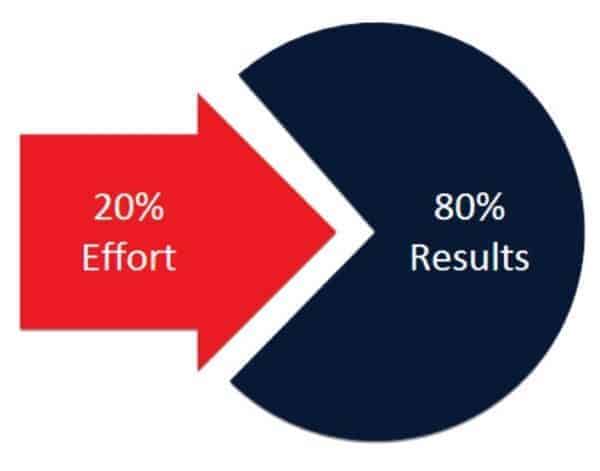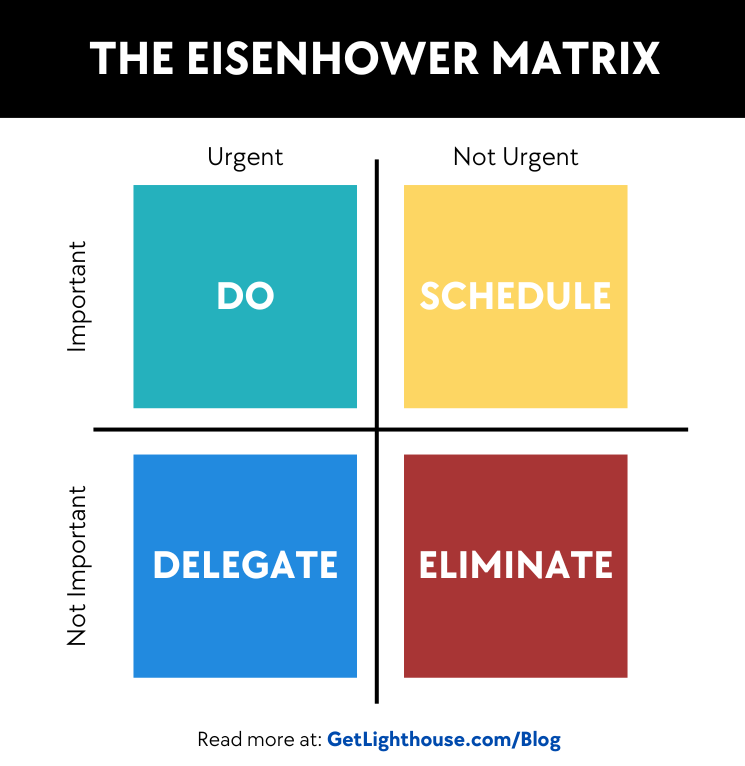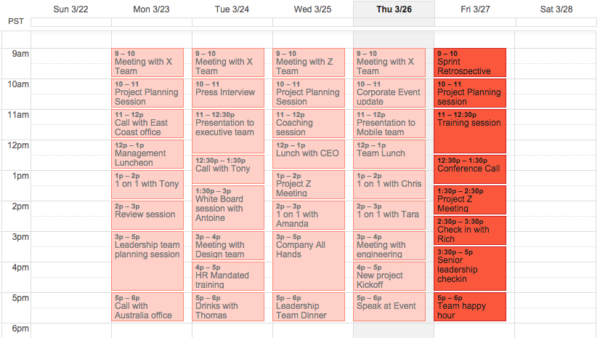"Time management is an oxymoron. Time is beyond our control, and the clock keeps ticking regardless of how we lead our lives. Priority management is the answer to maximizing the time we have."- John C Maxwell, best-selling author, speaker, & consultant on Leadership.
Time management vs. priority management
If you're a knowledge worker, you're probably undervaluing your time. If you waste a lot of time doing administrative things, creating your own systems and hacking Excel, Google Docs, and the like, you're probably not making the most of your time. There's also likely rudimentary tasks that you should be outsourcing to save you time, whether it be asking someone else to help you, hiring a virtual assistant, or using a 3rd party tool or service.
There is always more to be done as a manager. You may have a to-do list with a lot of items crossed off, but did you accomplish the most important things today?
Especially when others depend on you, you have to learn to make tough choices on what to do, what to put off, and what to say no to. That's where priority management comes in. Use these concepts to help you improve your time and priority management and get the right things done:
- Apply the Pareto Principle
- Use the Eisenhower matrix
- Do fewer $10/hr tasks and more $100/hr tasks
- Book your High Value time
- Remember the Monkey
- Be a Multiplier for Your Team
- Calculate Your Hourly Value
- Un-Clutter Your Mind
8 Ways to Use Priority Management to Get More of the Right Things Done

1) Apply the Pareto Principle (aka- the 80/20 rule)
One of the more oft-quoted concepts, the Pareto Principle, applies to both people and tasks: "roughly 80% of the effects come from 20% of the causes." With a little effort, you can find what work is having the deepest impact and the things you might even be able to stop doing.
This post from Simply Psychology has a great breakdown of different ways you can apply the 80/20 rule, including this one for :
"With the Pareto Principle, you can save time on work tasks and get more done in a shorter span of time.
For instance, you could spend some time at the start of the week planning out what you are going to focus on during the workdays, usually the most important tasks.
While this may feel like a waste of time, in the long run it can help you to focus and cut down work time."
How it applies to managers: Think about the work you're doing. Can you be doing more of the things that would have a higher impact? (ie- the 20%)
Also consider your people. Who on your team is delivering exceptional output and value?
Ensure you're investing in their success as the Pareto Principle teaches us that you'll see the greatest impact on your overall results with them. The less you and your team waste time on the wrong activities, the more you'll accomplish that matters.
In this way, the Pareto Principle sidesteps the time management vs. priority management debate; instead, it represents a great blend of both.

2) Use the Eisenhower matrix
Named after President Dwight D. Eisenhower, this handy table is a great visual aid to lean on during a busy week.
The key to applying this concept is to categorize the tasks on your to-do list both by urgency and importance. (And if you’re wondering how to define what constitutes an important task for yourself and your team, you might find the next section of this blog interesting.)

Following the chart’s logic, you should arrive at a four-tier structure of your daily or weekly priorities:
- Urgent and important tasks. Time-sensitive tasks you have ownership of should always be done by you. If they’re not already at the top of your to-do list, they should be moved up there and tackled as soon as possible. These are similar to the “eat the frog” principle we talk about here.
- Important, but not urgent tasks. These tasks should form the core of your schedule once the most urgent issues are addressed. Assess the approximate lengths of time it would take to complete them, and sketch out the rest of your day or week accordingly.
- Urgent, but not important tasks. Something came up that needs doing and your hands are already full? These are great tasks to delegate – low-stakes tasks that need to be completed quickly. Ask a capable team member to help you out with these, while offering guidance as needed.
- Not urgent and not important tasks. The last matrix quadrant is arguably the most useful. Any task that you sort into this category should be put off in favor of the others. We all have these time wasters that we get pulled into, but you want to avoid them. One study found 89% of people waste at least 30 minutes of work each day, so you could save 2.5 hours a week by sorting these out!
How it applies to managers: A stressful, busy workday can often make you feel as if every single task on your list is both urgent and important. That tunnel-vision feeling usually leads to people taking on everything by themselves, which only makes time and priority management more difficult.
The Eisenhower matrix helps your priority management in two major ways – by highlighting what you need to direct your attention to first, and what needs to be crossed off your to-do list. This gives you a clearer sense of direction, shapes your schedule, and improves delegation.

3) Do fewer $10/hr tasks and more $100/hr tasks
I learned this one from my father. He's always pushing his staff, and especially managers to, "focus on the $100/hr tasks and spend less time on the $10/hr tasks."
This means avoiding being bogged down by too many admin tasks, filing things, building your own framework in excel when an app could do it out of the box, or avoiding delegating work when you should. And those $100/hr tasks are those high-skill tasks that really add value, whether that be investing in relationships with clients, exploring new business opportunities, or spending more time on a consultation's complex problems.
My father has grown a business to millions in revenue by offloading those $10/hr tasks to a central office and letting his field staff focus on the high value services they provide clients. The central office experiences cost efficiencies by consolidating the work and his field staff are happy to not have to deal with those tasks - resulting in quality time and priority management for everyone.
How it applies to managers: Bring this mindset to any kind of work you do. Challenge yourself to consider which parts of your work (and your team) are $100/hr tasks, and which are lower value and should be delegated or eliminated.
A secret of Silicon Valley - and quality priority management - is how much work is actually done offshore and outsourced. It turns out, people can solve some problems (like identifying whether a photo is inappropriate) both better and cheaper than engineers writing and perfecting code to do it. What $10/hr work can you offload from yourself or your team?

4) Book your High Value time
If every meeting can get on your calendar, then so should your most important thinking and strategizing time. The 12 Week Year taught me this lesson as they advocate for two 3-hour blocks of time on your calendar each week. This is essential for priority management down the road.
The first block is a Strategic Block to focus on "Strategic and Money-making activities" and the second block is a Breakout Block, where you are to spend time doing non-work activities such as, "being creative, reading a book, or taking a walk."
I felt guilty at first taking these times, but have come to really appreciate them as my best ideas have often come during Breakout Blocks, and I could get lost in the day to day, never making time for big picture strategy, if I didn't set aside the Strategic block. If you've ever had a brilliant idea in the shower, then realize these blocks are creating more of those times for your subconscious to help you with tough problems and fresh ideas.
How it applies to managers: It's very easy to fall into reactive management, where you spend all your time doing short-term, pressing activities. Break out of that vicious cycle by booking some time for longer term thinking and getting out of your usual routine. You'll be more effective and you might just surprise yourself with the ideas that come to you.
5) Remember the Monkey
In my first job in tech, the founder of the company I worked at had me read, The One Minute Manager Meets the Monkey by best-selling leadership author Ken Blanchard. This book has one simple concept: every task must have ownership by a single person. Whomever owns the execution and outcome of the task has the monkey on their back. The monkey can only be on one person at a time, so the key lesson is to always be clear whose monkey it is.
After I read it, the founder and I even used the vocabulary, "whose monkey is this?" to help solidify the lesson and bring more accountability for both of us. It stopped us from having ideas come up of things that could be done and then having no one actually do them. Instead, it became clear when an idea was either tabled for later, or which of us (usually me because they were busy) would take ownership of the monkey.
How it applies to managers: Are you building accountability into your team? Is it clear who owns a project or task?
When you don't set clear accountability, it's much less likely a task will be done well nor done on time. When that happens, you spend more time on the project and miss out on the opportunity to empower your team. Remember to always be clear who has the monkey - this makes time and priority management easier for everyone.
6) Be a Multiplier for Your Team
When you manage a team, you are now responsible for many other people. Their combined productivity is significantly greater than your own. That means you must think hard about how you can be a multiplier for them instead of just a linear, individual contributor.
Where once you had a straightforward measurement of your productivity based on what you produced, now you must look at the complex effects of how things you do can impact your entire team. That's at the heart of the multiplier mindset - you can take a great concrete look at how it works for an engineering leader on this Youtube video (also embedded above).
How it applies to managers: Work to catch yourself when you try to brute force work by doing it yourself. Instead, look for opportunities to multiply the effectiveness of your team.
It can be tempting to do more individual contributor work when your company asks you to do some in addition to managing; resist that temptation when it comes at shortchanging high value managerial duties. Your team represents tremendous leverage as you unblock them, make them more efficient, and make sure their weekly priorities are the right things for your goals.
7) Calculate Your Hourly Value
You might be surprised how much an hour of your time is worth. If you make $100,000 a year and work 50 hours a week 50 weeks a year, your time at work is worth $40/hr. Multiply that $40 rate by your difference from a $100,000 salary and you know your rate, which for some Silicon Valley engineers in particular could be pretty stunningly high.
Realize that number means that anything that saves you time is worth an investment of at least that much; this insight will be crucial for your time and priority management tactics going forward.
If you're looking at a SaaS app, it's stunning how little it has to save you to pay for itself. For example, following the time value of $40/hr above, an app that costs $40/month would only need to save you 2 minutes per day to pay for itself, and that's before considering what you do with any time it saved you or your team.
How it applies to managers: Look at tools that can help you or your team's time and priority management. It's a lot more expensive to hire another employee than it is to pay for a few high-value SaaS tools that make you or their lives better. As long as it gets used, it's a great investment.
You can also bring this concept to your personal life, where I have saved a ton of time that I reinvested by at different times outsourcing my laundry (savings: ~6 hours/month) and buying SaaS apps like Buffer and Superhuman to make me more efficient.

8) Un-Clutter Your Mind
Getting things out of your mind and into a system you trust saves you mental load. This lets you focus on what's really important in that moment, subsequently improving your priority management.
As a study by Colorado State researchers found, "Notes allow interim pieces of information to be "stabilized” for use at a later stage in the task, thereby easing the load on the working memory."
Using an app that brings the structure for you will save you a lot of headaches and missed opportunities because you forgot or couldn't focus as well in the moment of a meeting. This can take the form of your To Do List app, a basic notes app, your CRM, or a tool to manage your team (like Lighthouse). All of them can help organize the information for use later when you need it again and are able to actually take action on it.
How it applies to managers: With all the context switching you have to do each day, and all the meetings you get pulled into, your only hope to stay on top of everything is to be organized.
Don't try to remember something in your head as you have to try to make an important decision on something else; chances are something will be forgotten. Trust the tools you use to help you and be present in each moment and for each decision you must make.
---
Looking for additional resources to level up your skills in priority management?
- Learn more about the Multiplier Mindset in our 4 Key Mindsets of Great Managers.
- Explore the finer points of delegating and coaching your team with the Task Relevant Maturity concept.
- Tackle procrastination with advice from Tim Urban’s TED Talk.
And if you've adopted these priority management principles, but are still struggling with delegation, we discuss learning how to remove yourself from your team with leadership coach Mathias Meyer – listen in on the conversation via the embedded link here:
What is a priority management?
Priority management describes the skill of knowing when to focus your professional time, effort and resources on accomplishing high-value projects over short-term tasks.
Why is priority management important?
Priority management helps you focus on the most important tasks and projects and not get bogged down by lower-value commitments. If done successfully, priority management helps you produce better quality of work, manage your schedule better and improve delegation.
What is the difference between time management and priority management?
Time management describes the skill of productively and effectively dividing your overall workload into different activities within a set time frame. Priority management means mastering these time management skills to focus on the most urgent and important tasks above all else and deliver the best possible results.
What are the 4 levels of prioritizing tasks?

One of the best (and easiest) ways to manage your priorities is to use the Eisenhower matrix. This 4-tier chart helps you categorize tasks on your to-do list by urgency and importance:
- DO: Urgent and important.
- SCHEDULE: Important, not urgent.
- DELEGATE: Urgent, not important.
- ELIMINATE: Not urgent and not important.
What are your top 3 priorities at work?
- Learn the Ropes: Gain knowledge on how things work and how you can pursue them successfully.
- Build Relationships: Gain trust from your team and learn to trust and delegate.
- Deliver Results: Learn how to differentiate low-impact from high-impact tasks and focus on the latter.
What are 5 time management strategies?
- Evaluate your work by urgency and importance.
- Prioritize high-value tasks and projects.
- Reduce and delegate lower-value and less important tasks.
- Focus on delivering results for urgent and important tasks.
- Limit distractions.






